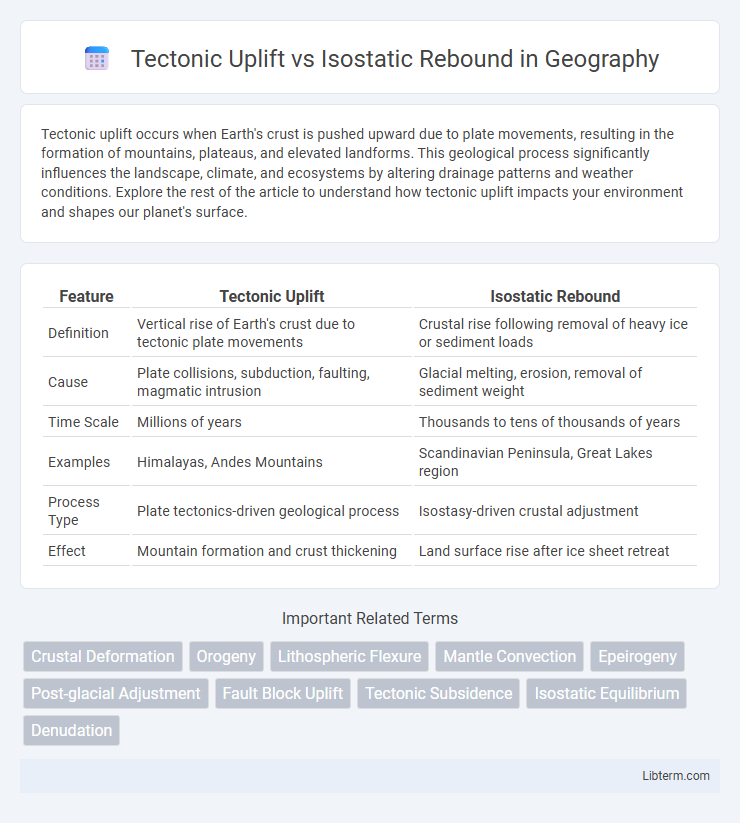Tectonic uplift occurs when Earth's crust is pushed upward due to plate movements, resulting in the formation of mountains, plateaus, and elevated landforms. This geological process significantly influences the landscape, climate, and ecosystems by altering drainage patterns and weather conditions. Explore the rest of the article to understand how tectonic uplift impacts your environment and shapes our planet's surface.
Table of Comparison
| Feature | Tectonic Uplift | Isostatic Rebound |
|---|---|---|
| Definition | Vertical rise of Earth's crust due to tectonic plate movements | Crustal rise following removal of heavy ice or sediment loads |
| Cause | Plate collisions, subduction, faulting, magmatic intrusion | Glacial melting, erosion, removal of sediment weight |
| Time Scale | Millions of years | Thousands to tens of thousands of years |
| Examples | Himalayas, Andes Mountains | Scandinavian Peninsula, Great Lakes region |
| Process Type | Plate tectonics-driven geological process | Isostasy-driven crustal adjustment |
| Effect | Mountain formation and crust thickening | Land surface rise after ice sheet retreat |
Introduction to Tectonic Uplift and Isostatic Rebound
Tectonic uplift refers to the vertical elevation of the Earth's surface caused by tectonic forces such as plate collisions, faulting, or volcanic activity, resulting in mountain building and landscape changes. Isostatic rebound occurs when the Earth's crust rises after the removal of heavy loads, such as glacial ice or sediment, due to buoyancy and mantle flow adjusting to the new equilibrium. Both processes contribute to landform evolution, but tectonic uplift is driven by plate dynamics while isostatic rebound is a response to surface load variations.
Defining Tectonic Uplift
Tectonic uplift refers to the vertical elevation of Earth's surface caused by tectonic forces such as plate collisions, volcanic activity, or faulting. This process leads to the formation of mountain ranges, high plateaus, and elevated landforms through crustal deformation and rock displacement. Unlike isostatic rebound, which is a response to the removal of surface loads like ice sheets, tectonic uplift directly results from active geodynamic processes shaping the planet's lithosphere.
Understanding Isostatic Rebound
Isostatic rebound occurs when the Earth's crust rises after the removal of a heavy load, such as melting glaciers, causing the mantle to flow back and restore equilibrium. This process differs from tectonic uplift, which results from plate tectonics and crustal deformation rather than adjustments to changes in surface mass. Understanding isostatic rebound is crucial for interpreting post-glacial sea-level changes and regional landscape evolution.
Geological Mechanisms Behind Tectonic Uplift
Tectonic uplift occurs as a result of plate tectonics, where the collision, subduction, or rifting of lithospheric plates causes the Earth's crust to rise. This geological mechanism involves the deformation and thickening of the crust, driven by compressional forces that generate mountain building and elevation changes. Unlike isostatic rebound, which is a response to unloading of crustal mass, tectonic uplift is primarily controlled by active plate boundary dynamics and mantle convection processes.
Causes and Processes of Isostatic Rebound
Isostatic rebound occurs when the Earth's crust rises after the removal of a heavy load, such as melting glaciers or erosion, causing a loss of downward pressure on the lithosphere. This process involves the lithosphere adjusting vertically as the mantle material flows back toward areas of reduced weight, restoring gravitational balance. Unlike tectonic uplift, driven by plate tectonics and mantle convection, isostatic rebound specifically responds to surface unloading and mantle viscosity changes.
Key Differences: Tectonic Uplift vs Isostatic Rebound
Tectonic uplift involves the vertical rise of Earth's crust driven by plate tectonic forces such as collision, subduction, or mantle convection, often resulting in mountain building and regional deformation. Isostatic rebound refers to the gradual rising of the crust after the removal of a heavy load like glaciers or large sediment deposits, restoring gravitational equilibrium without significant tectonic activity. The key difference lies in the causative mechanisms: tectonic uplift is driven by active plate movements, while isostatic rebound is a passive response to changes in surface loading.
Case Studies: Examples Around the World
Tectonic uplift is exemplified by the Himalayas, where the Indian Plate's collision with the Eurasian Plate has raised the mountain range at rates of about 5 mm per year, shaping Earth's highest peaks. Isostatic rebound is clearly observed in Scandinavia, where the Fennoscandian Shield has been rising up to 9 mm per year since the last Ice Age due to the melting of massive ice sheets reducing the crustal load. These distinct processes illustrate how crustal movements respond differently to tectonic forces and surface mass changes across diverse geological settings.
Impacts on Landscapes and Ecosystems
Tectonic uplift reshapes landscapes through the gradual elevation of Earth's crust, forming mountain ranges and altering drainage patterns, which creates diverse habitats and influences biodiversity distribution. Isostatic rebound occurs as the lithosphere rises after the melting of glacial ice, leading to the exposure of new land surfaces and changes in sea levels that affect coastal ecosystems and sedimentation patterns. Both processes drive geological transformations that impact soil development, vegetation zones, and wildlife migration, thereby shaping ecosystem dynamics over geological timescales.
Role in Earth’s Geological Evolution
Tectonic uplift drives mountain formation and continental growth by the movement of Earth's lithospheric plates, significantly shaping the planet's surface over millions of years. Isostatic rebound occurs when the Earth's crust responds to the removal of heavy loads, such as melting glaciers, leading to vertical land motion and landscape readjustment. Both processes play crucial roles in Earth's geological evolution by redistributing mass and altering topography, influencing erosion rates and sediment deposition patterns.
Future Implications and Scientific Research
Tectonic uplift and isostatic rebound both significantly influence landscape evolution, with future implications for seismic activity prediction and climate change models. Scientific research utilizes GPS monitoring and satellite data to distinguish ongoing uplift from rebound effects, enhancing hazard assessment accuracy. Understanding these processes improves forecasting of coastline shifts and informs infrastructure planning in vulnerable regions.
Tectonic Uplift Infographic

 libterm.com
libterm.com